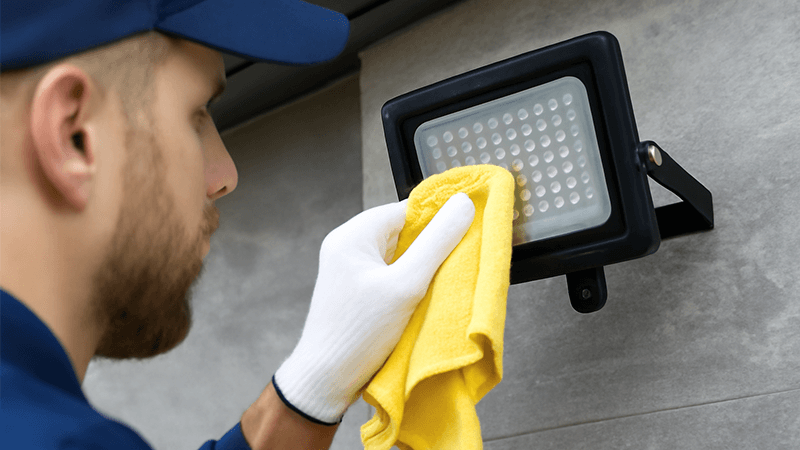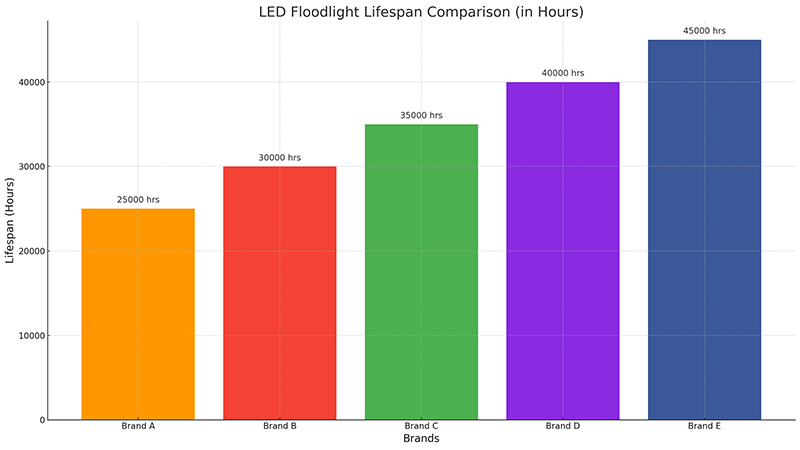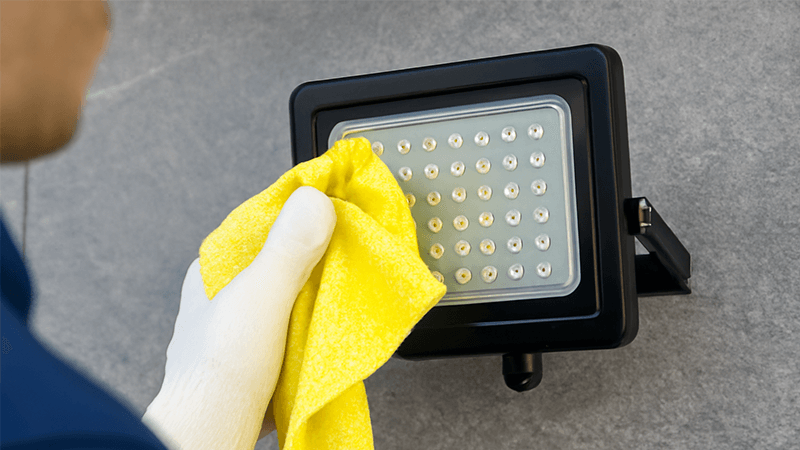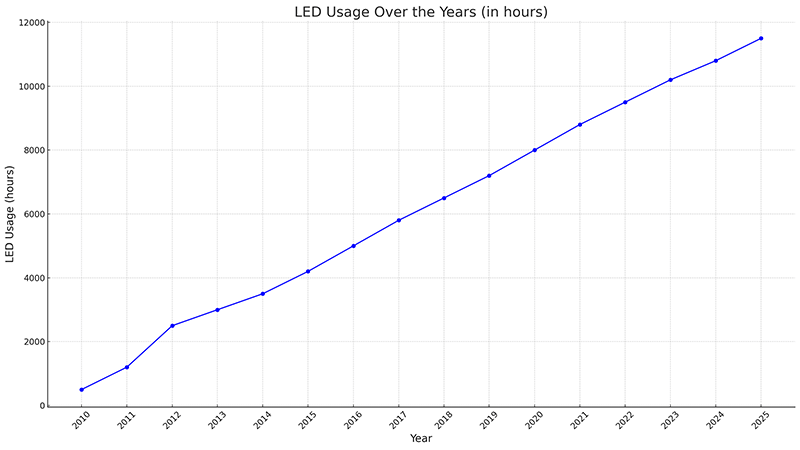Tired of your LED floodlights failing before their time? Early replacements hurt your budget and reputation. Here’s how simple maintenance ensures the long-lasting performance you were promised.
To maintain LED floodlights, you need to regularly clean the lenses and housing, check for secure connections, and ensure proper heat dissipation. Effective thermal management, using quality materials like aluminum heat sinks, is the most critical factor for a long lifespan.

I’ve seen countless projects succeed or fail based on one thing: how the lights were treated after installation. It’s not just about the quality you buy; it’s also about the care you provide. You have questions about lifespan and performance, and I have answers based on years of factory experience. Let’s break down exactly what you need to know to get the most out of your investment.
What is the lifespan of a LED floodlight?
Manufacturers claim impressive lifespans, but real-world results often fall short. This confusion can lead to bad purchasing decisions. Let me clarify what those "50,000-hour" ratings really mean.
A quality LED floodlight can last between 30,000 and 100,000 hours. The actual lifespan depends heavily on the quality of its components, especially the heat sink and driver, and the operating environment. This is often rated as L70, meaning its output drops to 70% of initial lumens.

The term "lifespan" can be misleading. When we talk about 50,000 hours, we aren’t saying the light will suddenly go dark. We’re usually referring to the L70 rating. Let me explain what that means in more detail.
Understanding L70 and Light Decay
L70 is the point where the LED’s light output has degraded to 70% of its initial brightness. For most applications, this is considered the end of its useful life. An LED doesn’t just "burn out" like a traditional bulb; it slowly fades away. This process is called lumen depreciation. The rate of this decay is the biggest factor in determining useful lifespan. A cheap light might hit its L70 mark in just 10,000 hours, while a high-quality one will last for 50,000 hours or more. I remember a client in the UAE, a purchasing manager much like Shaz, who was struggling with lights that dimmed dramatically after just one year. The issue wasn’t the LED chips; it was the poor thermal management accelerating this decay.
The Critical Role of Components
The lifespan isn’t determined by a single part. It’s a chain, and it’s only as strong as its weakest link. A premium LED chip won’t last if it’s paired with a low-quality driver or an inadequate heat sink. This is where my factory experience is so important. We obsess over every single component. Here’s a breakdown of the key parts and what you, as a buyer, should look for.
| Component |
Impact on Lifespan |
What to Look For |
| LED Driver |
The driver is the power supply. A failed driver means a dead light, even if the LEDs are fine. |
Isolated drivers, high power factor (PF >0.95), low Total Harmonic Distortion (THD <15%), proper surge protection. |
| LED Chips |
The source of light. Quality chips have slower lumen decay. |
Reputable brands like Cree, Lumileds, or Osram. Look for consistent color temperature and high CRI. |
| Heat Sink |
Manages temperature. Overheating is the #1 killer of LEDs. |
Extruded aluminum fins with a high surface area. Paired with high-quality thermal grease (≥3.0 W/m·K) is non-negotiable for me. |
A well-designed fixture ensures the heat generated by the LED chip is efficiently transferred away, keeping the junction temperature below the critical 85°C threshold. Anything higher drastically shortens the LED’s life and voids those impressive lifespan claims.
How to make your LED lights last longer?
You’ve invested in high-quality LED floodlights. But you want to ensure they last as long as possible. Here are the proactive steps you can take to protect your investment.
To make LED lights last longer, focus on three key areas: ensure proper installation for stable voltage, perform regular cleaning of the fixture to aid heat dissipation, and conduct visual inspections for any signs of damage or water ingress. A clean light is a cool light.

Extending the life of your LED floodlights goes beyond just buying a good product. It involves a simple but consistent maintenance routine. From my years of working with contractors, the ones who get the best results are those who don’t just "install and forget." They have a plan.
The Power of Proper Installation
A long lifespan starts on day one. During my early days, I saw a large installation for a sports field fail prematurely. The reason? The contractor used undersized wiring, causing voltage drops across the entire circuit. The drivers had to work overtime, which led to overheating and mass failure within 18 months. Correct installation is critical. This means using the right gauge wire, ensuring all connections are secure and waterproof, and verifying the supply voltage is stable and within the driver’s specified range. Don’t let a simple installation mistake cost you thousands in replacements. Also, ensure the fixture is mounted with adequate space around it for air to flow. A floodlight installed in a tight, enclosed space will trap heat and will not last.
A Simple Maintenance Schedule
Maintenance doesn’t have to be complicated. A simple schedule can make a huge difference. Dirt, dust, and grime on the surface of the floodlight, especially on the heat sink fins, act like a blanket. This blanket traps heat, causing the internal temperature to rise and shortening the life of the LEDs and the driver. Cleaning is the most effective maintenance task you can perform. Here is a simple schedule I recommend to my clients:
| Frequency |
Task |
Why It’s Important |
| Every 6 Months |
Visual Inspection: Check for physical damage, cracked lenses, or loose mountings. |
Early detection prevents bigger problems like water damage or the fixture falling. |
| Every 6-12 Months |
Cleaning: Wipe down the lens and the heatsink housing with a soft, damp cloth. |
Improves light output (a clean lens is brighter) and, more importantly, ensures efficient heat dissipation. |
| Annually |
Connection Check: For accessible fixtures, quickly check that electrical connections are still tight and free of corrosion. |
Loose connections can cause flickering, power issues, or create a fire hazard. |
This small effort protects your warranty and ensures you get the full rated life out of your lighting system. It’s a small price to pay for long-term reliability.
Why are my LED lights dying so fast?
It’s incredibly frustrating when your LED lights fail much sooner than expected. The costs add up quickly. I can help you identify the root causes so you can avoid them.
The most common reasons for early LED failure are overheating due to poor heat sink design, low-quality drivers unable to handle power fluctuations, and moisture getting inside the fixture. Often, it’s a combination of these factors, all stemming from a focus on low price over quality components.

When a client calls me and says his lights are dying fast, my mind immediately jumps to a checklist of potential causes. In my experience building these lights from the ground up, failure is rarely a mystery. It’s almost always a symptom of a specific design or environmental flaw. Let’s break down the three main villains.
Villain #1: Heat, The Silent Killer
As I’ve said before, heat is the number one enemy of LEDs. If your lights are failing, overheating is the most likely suspect. This doesn’t just happen in hot climates like the UAE; it happens when the light itself cannot get rid of its own heat. The cause is almost always a poorly designed heat sink. Some manufacturers cut costs by using less aluminum, which means less surface area to dissipate heat. I insist on using extruded aluminum fins with a high-quality thermal grease of at least 3.0 W/m·K. This combination creates an effective thermal bridge, pulling heat away from the LED chip and driver. A design that can’t keep the LED junction temperature below 85°C is a design that is doomed to fail.
Villain #2: The Unreliable Driver
The second most common culprit is a cheap driver. The driver converts AC power from the wall into the low-voltage DC power the LEDs need. It’s a complex piece of electronics, and it’s a common point of failure. Cheap drivers are sensitive to voltage spikes and sags. They have poor efficiency, which means they generate more heat of their own, compounding the problem. And they use low-quality capacitors that dry out and fail over time. When your supplier talks about the LED chips, always ask about the driver. A Mean Well or Sosen driver is a good sign; an unbranded one is a red flag.
Villain #3: Water and Dust Ingress
An outdoor floodlight needs to be sealed tight. The IP (Ingress Protection) rating tells you how well it is protected. For outdoor use, I never recommend anything less than IP65. A poor seal allows moisture and dust to enter the housing. Moisture can short-circuit the electronics instantly, while dust build-up can trap heat and lead to a slow death. I once dissected a failed light from a seaside project. The seals were cheap silicone that had cracked under the sun, allowing salty, humid air inside which corroded everything. It’s why we use durable, age-resistant seals on all our iPHD products.
How long do LED floods last?
The "50,000-hour lifespan" sounds great, but it’s hard to visualize. What does that actually mean for your project? Let me help you convert those hours into practical years of use.
An LED floodlight rated for 50,000 hours can last over 11 years if used 12 hours a day. If used only from dusk to dawn (around 8 hours), it could last over 17 years. However, this calculation assumes ideal conditions and high-quality components.

As a purchasing manager, you need concrete numbers for planning. A professional like Shaz needs to know if a light will last 5, 10, or 15 years to calculate the total cost of ownership. The big "hour" numbers on spec sheets can be confusing, so let’s translate them into a simple timeline.
Translating Hours into Years
The calculation is straightforward. You divide the rated lifespan in hours by the number of hours the light is used per day, and then divide that by 365 days a year. It’s a simple formula, but the "hours per day" variable is key. A light in a 24/7 security application will have a much shorter life in years than one used for architectural lighting that’s only on for 6 hours a night. Let’s look at a common scenario with a high-quality, 50,000-hour rated floodlight:
| Daily Usage |
Lifespan in Years (approx.) |
Common Application |
| 24 hours/day |
5.7 years |
24/7 Security, Industrial Sites |
| 12 hours/day |
11.4 years |
"Dusk to Dawn" Commercial Lighting |
| 8 hours/day |
17.1 years |
Residential Security, Signage |
| 4 hours/day |
34.2 years |
Landscape Accent Lighting |
The Important Caveat: Ideal vs. Real World
Remember, these calculations are based on the L70 rating we discussed earlier. This is the point at which the light output drops to 70%. The light doesn’t just stop working at 11.4 years. It will continue to produce light, just at a lower intensity. Furthermore, these numbers assume the light is operating in a suitable environment and that its components are high quality. I’ve personally tested fixtures that claim 50,000 hours but fail completely after just 15,000 hours due to overheating. That’s why I always tell my partners to look beyond the headline number. Scrutinize the thermal management—ask about the heat sink material, the thermal grease conductivity (≥3.0 W/m·K), and the maximum junction temperature (<85°C). These details tell you if that 50,000-hour promise is a reality or just marketing fantasy.
Conclusion
Proper maintenance and choosing quality components are key to a long LED lifespan. Focus on heat management, regular cleaning, and proper installation to protect your investment and ensure reliable performance.